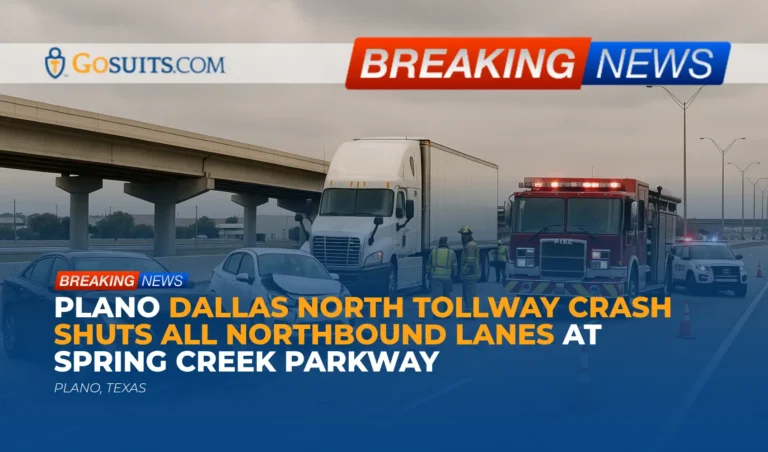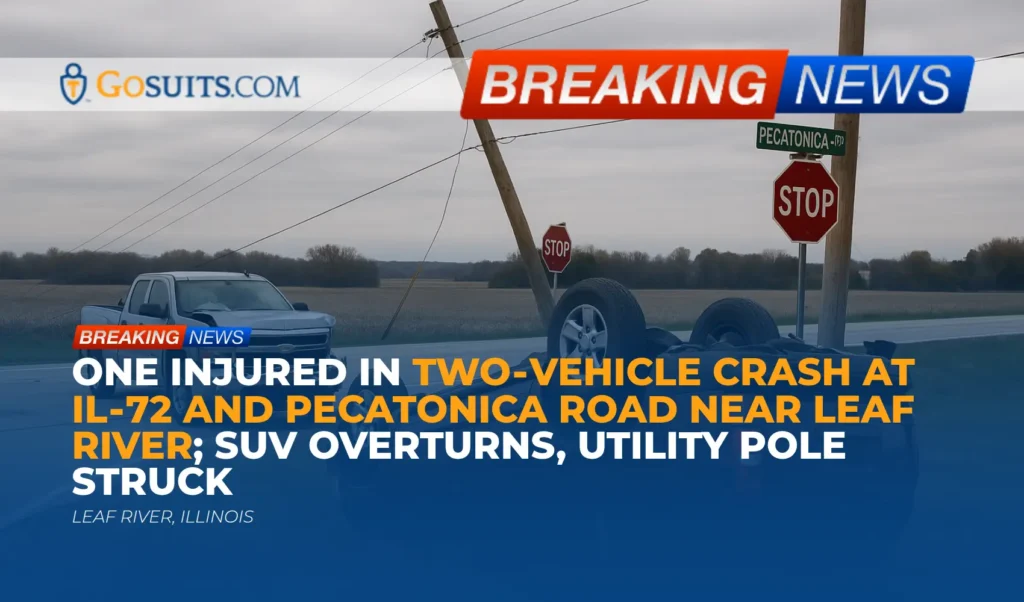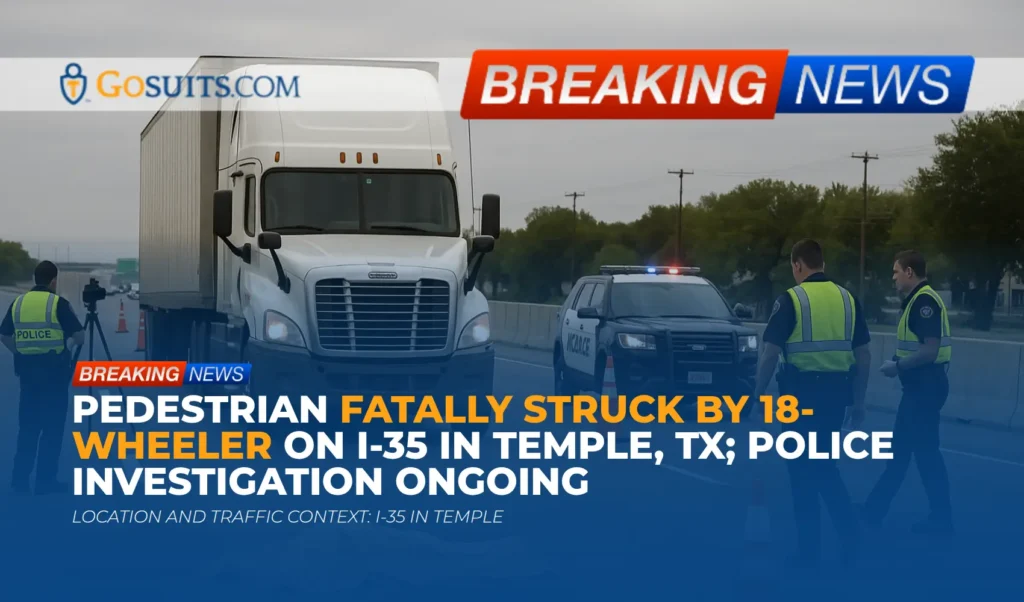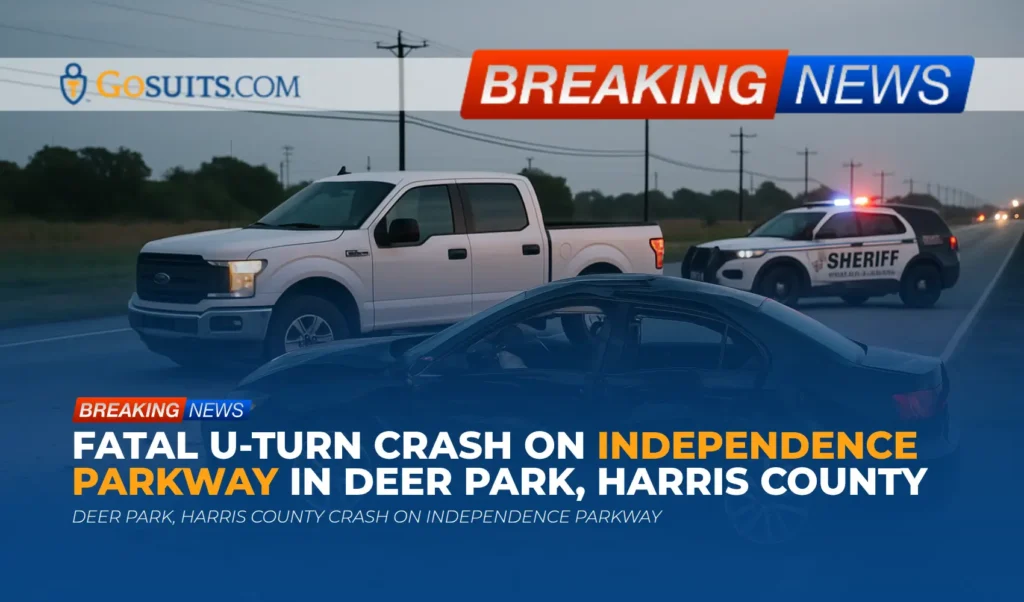- What we know about the Plano tollway crash
- Why lane closure crashes can be dangerous
- Immediate steps after a tollway crash
- How to get official records and where to call
- Key Texas laws that may apply
- Potential civil liability in tollway crashes
- Insurance considerations in Texas
- If a serious injury or death occurred
- Preserving and accessing evidence
- Common pitfalls when dealing with insurers
- How timelines and deadlines work after a crash
- Local resources and support in and around Plano
- Commentary from Gosuits Plano, Texas Personal Injury Attorney
- Why timely action matters now
What we know about the Plano tollway crash
On Tuesday morning, October 21, 2025, a crash in Plano led to the closure of all lanes of the northbound Dallas North Tollway at Spring Creek Parkway. The closure caused heavy delays during the morning commute. At the time of the early reports, it was not immediately clear how many vehicles were involved or whether there were injuries. Road closures of this kind typically indicate that first responders needed the full roadway to secure the scene, render aid, and investigate the cause.
Location context matters. Spring Creek Parkway is a major east west thoroughfare in Plano, and the Dallas North Tollway is a high speed, limited access facility. When lanes are shut down on this corridor, there is a significant risk of secondary collisions as traffic stacks up behind the original crash. The agencies that may be involved in response and follow up can include local police in Plano, the regional tollway authority’s police, fire and EMS, and, in some cases, the Texas Department of Public Safety for traffic enforcement support.
Why lane closure crashes can be dangerous
Full lane closures on limited access highways can increase the risk of secondary crashes, especially when congestion builds quickly and drivers approach at high speed. Federal transportation agencies have long noted the link between unexpected queuing and additional collisions. The Federal Highway Administration, a part of the United States Department of Transportation, highlights that effective traffic incident management and quick clearance reduce secondary crash risk and improve responder safety. This is why drivers are required to slow down and move over for stopped emergency vehicles and incident scenes. See the U.S. Department of Transportation’s FHWA guidance on traffic incident management at ops.fhwa.dot.gov.
In practical terms, that means that after the initial collision, trailing drivers who are inattentive or following too closely may collide with stopped traffic. Commercial traffic adds additional risk because of weight and stopping distances. Even if the first collision seems minor, the cascading effects of a full closure can magnify harm unless motorists reduce speed and leave adequate space.
Immediate steps after a tollway crash
After any crash on a high speed corridor, safety comes first. If it is safe to do so, move vehicles out of the travel lanes. Texas promotes quick clearance for minor crashes when possible. Turn on hazard lights, set out flares or triangles if available, and keep seat belts on until you are sure you are clear of live traffic. Call 911 to report the crash and request medical assessment even if injuries seem minor. Adrenaline can mask symptoms of concussion, neck injuries, and internal trauma.
Collect information if you can do so safely. Photograph vehicle positions, roadway markings, damage, and any debris. Capture the surrounding scene, including traffic control devices, signage, and weather conditions. Exchange information with other drivers and witnesses. If a commercial vehicle is involved, note the company name, unit number, and DOT number visible on the truck.
Seek medical care promptly. Documentation in the first hours and days after a collision helps treat injuries and creates a clear record that connects symptoms to the crash. Keep all discharge papers, imaging reports, prescriptions, and follow up recommendations.
Before speaking with any insurance company, including your own, consider consulting with a seasoned attorney. Statements given early can be misconstrued. What you say to an insurance adjuster can be used against you later in ways that may affect fault assessments, damages arguments, and access to benefits.
How to get official records and where to call
Police crash report
In Texas, crash reports are governed by state law and can be requested by individuals with a proper interest under Transportation Code section 550.065. You can review the statute here: statutes.capitol.texas.gov. Reports are typically available a few days after the incident once the investigating agency files the report.
For a crash within Plano city limits, start with the Plano Police Department. The department’s website is here: plano.gov. The Records or Public Safety Records unit can provide guidance on how to request a copy of a crash report and any available supplemental materials. Be ready with the date, time, location, and the names of involved parties if known.
Texas crash reports are also managed statewide by the Texas Department of Transportation. TxDOT explains crash records and public access on its website: txdot.gov. TxDOT provides a system for obtaining official copies once they are submitted by the investigating officer.
Autopsy or medical examiner records
If a fatality occurred, the county medical examiner is the office that performs autopsies and maintains related records. Plano is located in Collin County. The Collin County Medical Examiner provides information on autopsy reports and procedures here: collincountytx.gov. Family members can contact the office for status updates and instructions on how to request reports once completed. Autopsy reports typically take several weeks depending on toxicology.
For death certificates, the Texas Department of State Health Services Vital Statistics program maintains statewide death records. Information on ordering a death certificate is available here: dshs.texas.gov.
Public information requests
Texas has a broad Public Information Act that allows access to records held by governmental bodies, subject to certain exceptions. If you believe a governmental entity holds relevant records, you can make a written request citing Texas Government Code Chapter 552. The statute can be reviewed here: statutes.capitol.texas.gov. This can be useful for requesting communications, dispatch logs, traffic camera footage, or maintenance records related to the roadway condition, subject to legal restrictions and retention schedules.
Key Texas laws that may apply
Fault and proportionate responsibility
Texas uses proportionate responsibility to apportion fault among parties. If a case proceeds to litigation, a claimant who is more than 50 percent responsible cannot recover damages. See Texas Civil Practice and Remedies Code Chapter 33 at statutes.capitol.texas.gov.
Statute of limitations
Most personal injury and wrongful death claims in Texas must be filed within two years of the date of injury or death. See Texas Civil Practice and Remedies Code section 16.003 at statutes.capitol.texas.gov. Special timelines may apply for minors or certain governmental claims.

Claims involving governmental entities
If a claim involves a governmental unit, different rules apply, including strict notice requirements and limitations on damages. Texas Civil Practice and Remedies Code Chapter 101, often called the Texas Tort Claims Act, governs many of these claims. See sections 101.021 and related provisions here: statutes.capitol.texas.gov. There is also a statutory notice requirement that generally requires written notice within six months of the incident, and some local charters require shorter notice. See section 101.101 here: statutes.capitol.texas.gov.
Minimum liability insurance
Texas law requires drivers to carry at least minimum financial responsibility limits, often referred to as 30/60/25 coverage. See Transportation Code section 601.072 at statutes.capitol.texas.gov. Actual losses in serious collisions often exceed these minimums, which is why investigating whether additional coverage applies is important.
Potential civil liability in tollway crashes
Without speculating about the specific Plano crash, here are common liability questions that arise in highway incidents:
- Negligent driving. Speeding, following too closely, distracted driving, improper lane changes, and failure to control speed are frequent causes of multi vehicle collisions on limited access roads.
- Commercial vehicle responsibility. If a commercial motor vehicle is involved, the employer may share liability under respondeat superior for negligent acts of the driver acting within the scope of employment. Additional claims sometimes arise for negligent hiring, training, or supervision, depending on the facts and proof available.
- Roadway conditions. Debris, fluid spills, or malfunctioning traffic control devices can contribute to crashes. Claims that involve roadway defects or maintenance may implicate governmental units and the special rules discussed above.
- Secondary collisions. When a primary crash creates a sudden stop in traffic, trailing drivers may cause additional impacts. Evaluating secondary crashes requires careful timing analysis, data from vehicle event data recorders, and any available camera footage.
Insurance considerations in Texas
Insurance coverage analysis often includes multiple layers:
- At fault driver liability. The at fault driver’s liability coverage is the first layer of recovery. Determining fault requires the police report, scene evidence, and sometimes reconstruction.
- Underinsured or uninsured motorist coverage. Your own policy may provide UM or UIM coverage if the at fault driver lacks enough insurance. These coverages can apply even when you are a passenger, depending on policy terms.
- Personal injury protection and MedPay. Texas policies may include PIP. PIP can pay certain medical bills and lost wages regardless of fault. Review your declarations page to see what applies.
- Commercial policies. If a commercial vehicle is involved, higher policy limits may be available. Identifying the correct corporate entities and policy carriers is crucial.
Before making a recorded statement or signing medical authorizations for any insurer, consider speaking with an attorney. Insurance companies are skilled at narrowing claims using early statements. What is said in the first 24 to 72 hours can affect the valuation and trajectory of a claim.
If a serious injury or death occurred
When a tollway crash results in catastrophic injury or the loss of a loved one, families face urgent decisions amid grief. Wrongful death and survival claims in Texas are governed by statute. The statute of limitations is generally two years, though the time can run differently in certain circumstances. See Texas Civil Practice and Remedies Code section 16.003 at statutes.capitol.texas.gov.
Families may need several documents for benefits and claims:
- Death certificate. Available through the Texas Department of State Health Services Vital Statistics program at dshs.texas.gov.
- Autopsy report and medical examiner file. For Plano incidents, contact the Collin County Medical Examiner at collincountytx.gov.
- Police crash report and supplements. Request through the Plano Police Department Records unit at plano.gov and through TxDOT for the official crash report process at txdot.gov.
These records establish the cause and manner of death, help with insurance claims, and support any civil claim brought by the statutory beneficiaries. Families can also inquire about victim assistance services offered by local agencies to help with immediate needs such as notifications and coordination.
Preserving and accessing evidence
Evidence can disappear quickly after a highway crash. Physical debris is cleared, vehicles are repaired or salvaged, and digital data overwrites. Steps that commonly help preserve proof include:
- Vehicle preservation. If there are serious injuries, notifying the owner and any insurance carriers in writing to preserve the vehicle and its event data recorder is important. If a commercial vehicle is involved, counsel often requests preservation of the tractor and trailer, electronic logging data, and inspection records.
- Scene documentation. Photographs and videos taken at the scene help anchor the timeline and relative positions of vehicles. Note skid marks, gouges, and fluid trails.
- Public records. Use the Texas Public Information Act to request dispatch audio, CAD logs, and, where available, traffic camera recordings. See Government Code Chapter 552 at statutes.capitol.texas.gov.
- Medical records. Keep organized copies of hospital and clinic records, imaging, and billing statements. Consistent documentation links injuries to the incident and helps quantify damages.
Common pitfalls when dealing with insurers
- Early recorded statements. Adjusters may request a recorded statement within hours. Decline until you have had a chance to consult an attorney. Statements can be used to limit liability or downplay injuries.
- Broad medical authorizations. Forms that allow access to years of medical history can shift focus to unrelated conditions. Narrow the scope to crash related care.
- Quick settlements. Early offers often occur before the full extent of injuries and future care needs are known. Once released, claims are usually final.
- Social media. Posts can be misinterpreted. Consider pausing public posts until the claim is resolved.
How timelines and deadlines work after a crash
Several clocks may start running immediately after an incident:
- Presuit notice. If a governmental unit might be involved, written notice may be due within six months under Texas Civil Practice and Remedies Code section 101.101. Some cities have even shorter local notice rules.
- Insurance reporting. Policies often require prompt notice of a loss. Provide basic notice without making detailed statements until you speak with an attorney.
- Limitations. Most personal injury and wrongful death civil claims must be filed within two years. See section 16.003 at statutes.capitol.texas.gov.
- Evidence retention. Some digital data, like dash camera footage or truck telematics, may overwrite within days or weeks. Send preservation requests early.

Local resources and support in and around Plano
In serious incidents, people often need to know where to turn for timely, reliable information. The following government resources can help:
- Plano Police Department. General department page and access point for Records and crash report requests: plano.gov.
- Texas Department of Transportation. Statewide information on crash reports and roadway safety initiatives: txdot.gov.
- Collin County Medical Examiner. For autopsy status and reports in fatalities: collincountytx.gov.
- Texas Department of State Health Services Vital Statistics. For death certificates and vital records: dshs.texas.gov.
- Texas statutes online. Transportation Code crash report access, proportionate responsibility, and related civil statutes: statutes.capitol.texas.gov.
- FHWA Traffic Incident Management. Federal guidance on safe clearance and secondary crash reduction: ops.fhwa.dot.gov.
Commentary from Gosuits Plano, Texas Personal Injury Attorney
We are thinking of everyone affected by the northbound Dallas North Tollway closure at Spring Creek Parkway and the ripple effect it had on families and commuters. Collisions on limited access roads are frightening, and the uncertainty in the early hours is stressful. This commentary is offered for educational and general information purposes.
From a civil injury perspective, a full lane closure usually means responders were securing a dynamic and potentially hazardous scene. In our experience, key facts that often matter include approach speeds, traffic density at the time, whether secondary impacts occurred, and whether any commercial vehicles were involved. The location near a major Plano interchange can add complexity because traffic merges and diverges, which can influence fault analysis. Careful collection of evidence, early preservation of vehicles and data, and obtaining the official crash report are essential steps toward clarity.
Insurance companies and large corporate stakeholders move quickly after highway crashes. They often collect statements, download vehicle data, and build narratives that minimize responsibility. When individuals navigate this process alone, small inconsistencies or casual remarks can be emphasized to shift blame or to discount the seriousness of injuries. It is common to see broad authorizations for medical records, early settlement offers that do not account for ongoing care, and requests for recorded statements before people have had the chance to review the police report.
A free consultation can help people understand their rights, identify time sensitive steps, and avoid preventable mistakes before speaking with any insurer. Even a short conversation can help with questions about medical bills, vehicle preservation, potential governmental notice requirements, and what to expect as the official report becomes available.
Why timely action matters now
- Identify and preserve evidence immediately. Vehicles can be repaired or salvaged within days. Event data recorders may be overwritten and traffic camera footage can be purged according to short retention schedules. Acting now increases the chance of capturing photographs, dashcam files, and third party video that will not exist later.
- Protect health and document injuries. Early medical evaluation creates a clear link between the crash and symptoms. Delays can complicate both treatment and documentation, making it harder to establish the full scope of injury and future care needs.
- Avoid harmful statements. Insurance adjusters often contact people within hours. Waiting to understand rights before making recorded statements or signing authorizations helps prevent missteps that can limit available benefits or shift fault.
- Meet strict deadlines. Some claims require written notice within months, not years, especially if a governmental entity may be implicated. Missing a notice window can narrow or eliminate certain avenues of recovery later on.
- Clarify insurance coverage early. Multiple policies may apply, including liability, UM or UIM, PIP, and commercial layers. Early review helps ensure required notices are provided and that no coverage is unintentionally waived.
- Coordinate vehicle and property issues. Rapid coordination with impound lots and insurers helps secure the vehicle for inspection, preserves physical evidence, and prevents unnecessary storage charges.
- Set expectations for the process. Understanding the typical sequence from crash report filing to claim evaluation reduces stress and helps with informed decision making at each stage.






